On August 1st, 2009 Seoulites welcomed their city’s newest landmark. After 15 months of renovation, Gwanghwamun Plaza (광화문 광장) is now open to the public and is sure to become a major city attraction.
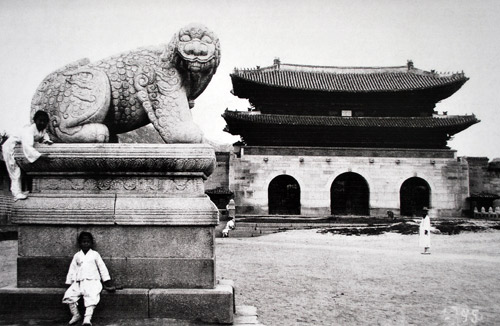 Caption TK.
Caption TK.
Actually, although it’s received a major face-lift, the area isn’t new at all. Located at the south gate of Gyeongbok Palace (경복궁), Sejong Boulevard has long been the heart of the 600-year-old city, with the city’s guardian, Mt. Bugaksan, looming in the background. But what was 16 lanes of traffic is now punctuated by a 19,000 square meter public plaza.
 An artist’s rendering of the 557-meter long Gwanghwamun Plaza, opened to the public on August 1, 2009.
An artist’s rendering of the 557-meter long Gwanghwamun Plaza, opened to the public on August 1, 2009.
At a cost of 47 billion won, or about $38 million, six lanes of traffic were converted into a 34 x 557 meter plaza. The unifying theme is Korean national identity and the city’s history. Both sides of the park feature a narrow waterway where 617 stone plates depict historic events from Seoul’s founding until 2008.
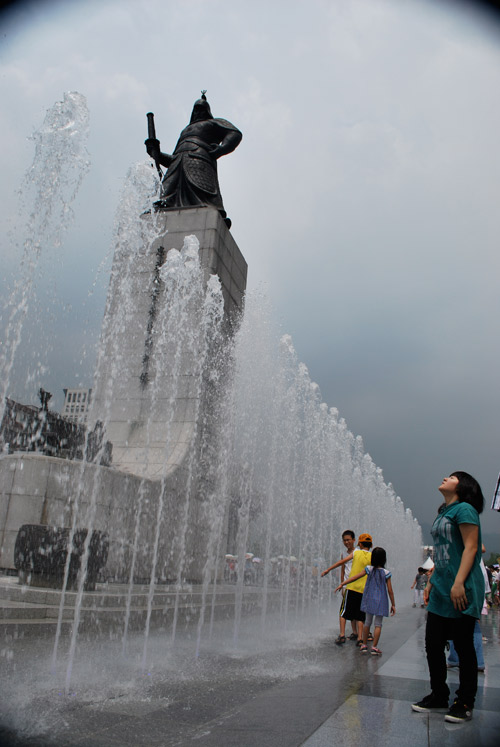 Some 364 water jets surround the statute of Korea’s greatest naval hero, Admiral Yi Sun-shin.
Some 364 water jets surround the statute of Korea’s greatest naval hero, Admiral Yi Sun-shin.
A statue of Korea’s greatest naval hero, Admiral Yi Sun-shin (이순신), steals the show. His likeness stands amid 364 water jets, some of which shoot 20 meters into the air. Although city workers tried to keep people out of the fountains on opening day, kids seem drawn to water like magnets.
 The “Flower Carpet” is said to contain over 224,000 plants.
The “Flower Carpet” is said to contain over 224,000 plants.
Behind the Admiral is an elaborate “Flower Carpet,” where city officials claim that 224,537 flowers are planted – one to represent each day since October 28, 1394, when King Taejo founded the Joseon Dynasty and moved Korea’s capital to Seoul.
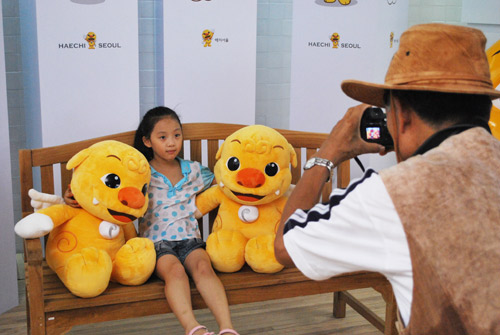 Seoul City is trying its best to make the city synonymous with the yellow/orange mythical beast named Haechi.
Seoul City is trying its best to make the city synonymous with the yellow/orange mythical beast named Haechi.
Underneath the fountain is a recessed space called the “Haechi Madang.” “Madang” means “court” in Korean, and Haechi is Seoul’s new mascot. Inspired by the haetae (해태), a mythical, fire-eating creature that has guarded ancient Seoul’s palaces, city officials are doing their best to secure the friendly orange beast as a city symbol.
 Inside the Haechi Madang is a photo exhibit on the “Squares of Europe,” a historically unfamiliar concept in Korean architecture.
Inside the Haechi Madang is a photo exhibit on the “Squares of Europe,” a historically unfamiliar concept in Korean architecture.
To this end, most of the madang is filled with Haechi paraphernalia… stone Haechi, stuffed Haechi, giggling video of Haechi… But also on display is a photo exhibit of European plazas. Because unlike European cities, large public squares aren’t part of Korea’s architectural tradition.
 You just can’t keep kids out of the water on a hot day.
You just can’t keep kids out of the water on a hot day.
That said, given the 370,000 people gathered on Saturday and Sunday to officially open the plaza, Koreans seem to be taking to public spaces with enthusiasm. Attendees to the Saturday evening grand opening were treated to an elaborate ceremony, featuring a chorus and orchestra, a huge Korean flag made from handprints, and congratulatory video messages from the majors of Beijing, London and Sao Paulo, Brazil.
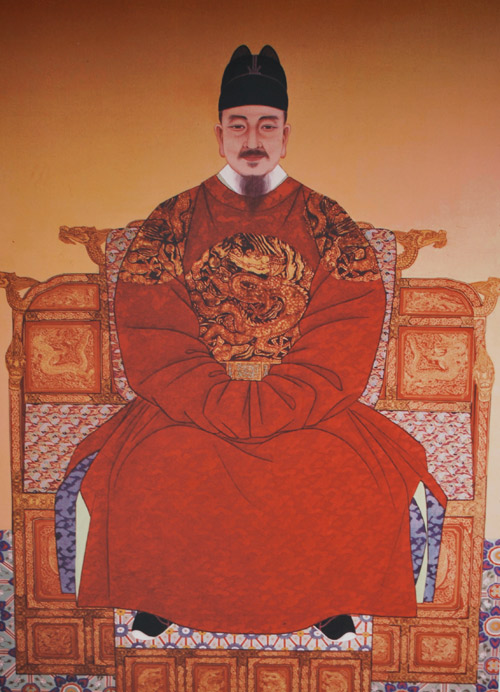 In October, a second recessed area will celebrate the reign of King Sejong the Great, who promulgated the Korean written language, Hangul.
In October, a second recessed area will celebrate the reign of King Sejong the Great, who promulgated the Korean written language, Hangul.
In October, a statue of Korea’s greatest king, King Sejong the Great will be seated on the plaza. Another underground space will showcase the ingenuity of Hangul (한글), the written Korean language promulgated by him in the 15th century.
 A colorful facade obscures the Gwanghwamun gate, which is currently undergoing renovation.
A colorful facade obscures the Gwanghwamun gate, which is currently undergoing renovation.
But the plaza won’t be truly complete until the massive gate for which it’s named is finished. Under renovation since 2006, Gyeongbok Palace’s grand Gwanghwamun Gate is scheduled to be completed in late 2009. Until then, visitors can view an exhibit featuring photographs of the gate from the 19th century to the present.
 This June 10, 2009 protest took place in front of City Hall at Seoul Plaza, a favorite site for large-scale protests.
This June 10, 2009 protest took place in front of City Hall at Seoul Plaza, a favorite site for large-scale protests.
It seems like the plaza is already exceeding expectations, but that’s not to say there aren’t some concerns. Despite being located in the midst of busy traffic, there’s no safety fencing. Furthermore, police and city officials have banned all demonstrations at the plaza, fearing it could become the site of Seoul’s infamous mass protests. That decision was almost immediately challenged by civic and opposition groups. During an August 3rd press conference protesting the move, several people were arrested by police.
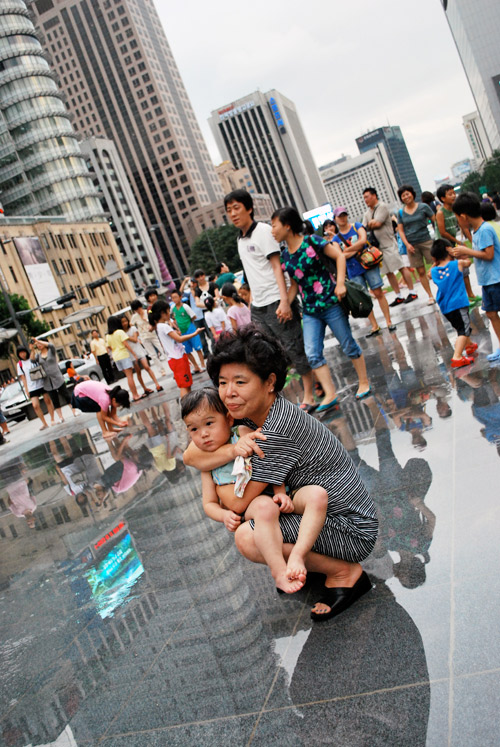 The Plaza is already a popular destination for families.
The Plaza is already a popular destination for families.
While it’s a bit early to say what’s in store for the Plaza in the years to come, it seems inevitable that this new Seoul landmark will feature prominently in the city’s future.
Getting There:
→ The Gwanghwamun Plaza can be accessed directly from Seoul Metro Line 5’s Gwanghwamun Station (exits 2, 3, 4 or 7) or a short walk eastward from Line 3’s Gyeongbokgung Station (exit 6).
(A version of this text aired on KBS World Radio on August 5, 2009.)



Matt,
I found this site a week or two ago and I fell in love. I am moving to Southern Korea in about 2 months. Your videos are great! and informative! Thank you so much for the blog!
-Chris
By: Chris on 13 August 2009
at 11:39
Hi Chris,
Glad you found the site and really glad you like it. Good luck on your impending move! Best, Matt
By: Matt Kelley on 14 August 2009
at 00:54
I am really enjoying your site. My husband and I are in the process of adopting a little boy from South Korea and should be traveling there in the next month or so. I am trying to learn as much as I can about South Korea so that I can teach him about his culture, and this site has been a wonderful resource! Any suggestions on where we should stay when we are in Seoul? We have been told The Somerset is a great place to stay…
By: Lori on 14 August 2009
at 05:41
Hi Lori,
It’s wonderful that you’re committed to learning a lot about Korea. I’ve done a lot of work with Korean adoptees, and personally I think it’s great that many of the current generation of prospective adoptive parents are choosing to honor and incorporate their kid’s birth culture into their lives.
Re: places to stay, I haven’t stayed at the Somerset (I think there’s more than one location), but I’ve attended some lectures at the one in Jongno, and the facilities seem very nice and centrally located. For a totally different experience, you could spend the night in a traditional “hanok” -style inn in the Bukchon area, located just east of Gyeongbok Palace. A cool place, but definitely without some of the conveniences of a modern hotel. Let me know if you want more information.
Good luck to you! ~Matt
By: Matt Kelley on 16 August 2009
at 23:13
Thanks so much for your advice. We would love to try that! One more question…would it be okay for me to put a link of your blog on our blog? We would love for our family and friends following our journey to learn more about South Korea with us!
Thanks!
~Lori
By: Lori on 17 August 2009
at 08:24
Hi Lori,
Of course you can. I noticed a spike in visits from your post on the Holt message boards, so thanks a lot for that. I’ll look into the hanok option and will get back to you. ~Matt
By: Matt Kelley on 19 August 2009
at 08:34